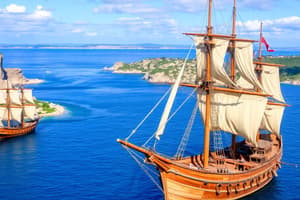Podcast
Questions and Answers
What was the main reason for European sailors to explore sea routes to reach the Indian subcontinent?
What was the main reason for European sailors to explore sea routes to reach the Indian subcontinent?
- To establish diplomatic relations with Indian rulers
- To study the geography of the Indian Ocean
- To acquire valuable spices and textiles (correct)
- To find new territories for colonization
Why did Christopher Columbus sail westwards across the Atlantic Ocean?
Why did Christopher Columbus sail westwards across the Atlantic Ocean?
- To prove the curvature of the Earth
- To find a faster sea route to India (correct)
- To discover new lands for colonization
- To study ocean currents and wind patterns
What was the significance of Vasco da Gama's landing in Calicut in 1498?
What was the significance of Vasco da Gama's landing in Calicut in 1498?
- It established diplomatic ties between Portugal and India
- It initiated a conflict between European powers over Indian territories
- It marked the beginning of European trade with India (correct)
- It led to the discovery of America
What legal document granted the English East India Company permission to trade with India?
What legal document granted the English East India Company permission to trade with India?
In what present-day Indian state did Vasco da Gama first land in 1498?
In what present-day Indian state did Vasco da Gama first land in 1498?
Why did Siraj-ud-Daulah, the Nawab of Bengal, battle against the British in 1757?
Why did Siraj-ud-Daulah, the Nawab of Bengal, battle against the British in 1757?
What was the significance of the Battle of Plassey in 1757?
What was the significance of the Battle of Plassey in 1757?
What was the outcome of the Battle of Buxar fought in 1764?
What was the outcome of the Battle of Buxar fought in 1764?
How did the Great Uprising of 1857 impact the rule of the East India Company?
How did the Great Uprising of 1857 impact the rule of the East India Company?
What were some factors that led to the Great Uprising of 1857?
What were some factors that led to the Great Uprising of 1857?
Flashcards are hidden until you start studying
Study Notes
European Exploration of India
- Traders and travelers from distant places visited India since ancient times
- During the 15th century, European sailors, including Vasco da Gama, explored sea routes to reach the Indian subcontinent
- Vasco da Gama landed in Calicut (present-day Kozhikode) in Kerala on 20 May, 1498, opening the gates of India for Europeans
The East India Company
- Founded by English traders in 1600
- Acquired a Charter from Queen Elizabeth I, granting permission to trade with India
- Established factories at different locations such as Ahmedabad, Burhanpur, Agra, and Surat
- Set up a fortified factory at Sutanati, Calcutta, known as Fort William in 1696
British Exploitation in India
- The British traders deprived local rulers of their revenues, causing enormous loss of revenue
- Siraj ud Daulah, the Nawab of Bengal, fought the Battle of Plassey against the British in 1757 to check their evil intentions
- The British won the Battle of Plassey with the help of Mir Jafar, who joined hands with them
- The British victory in the Battle of Buxar in 1764 strengthened their position in India, granting them the right to collect land revenue of Bengal, Bihar, and Orissa
The Great Uprising of 1857
- The East India Company faced a massive uprising that ended its rule in India
- The Great Uprising of 1857 marked the turning point of Indian history
- Factors leading to the uprising include:
- Exorbitant taxes collected by the British, which impoverished the people in India
- Taxes levied by the British destroyed Indian handicrafts
- The British annexed some Indian states under the policies of Subsidiary Alliance and Doctrine of Lapse to expand their control over India
Studying That Suits You
Use AI to generate personalized quizzes and flashcards to suit your learning preferences.




